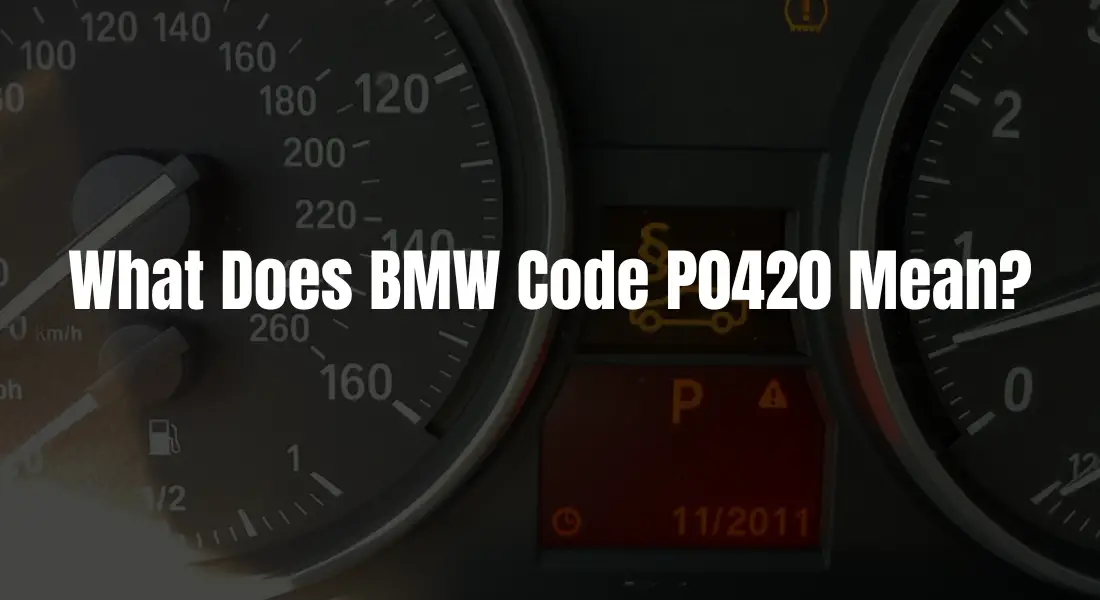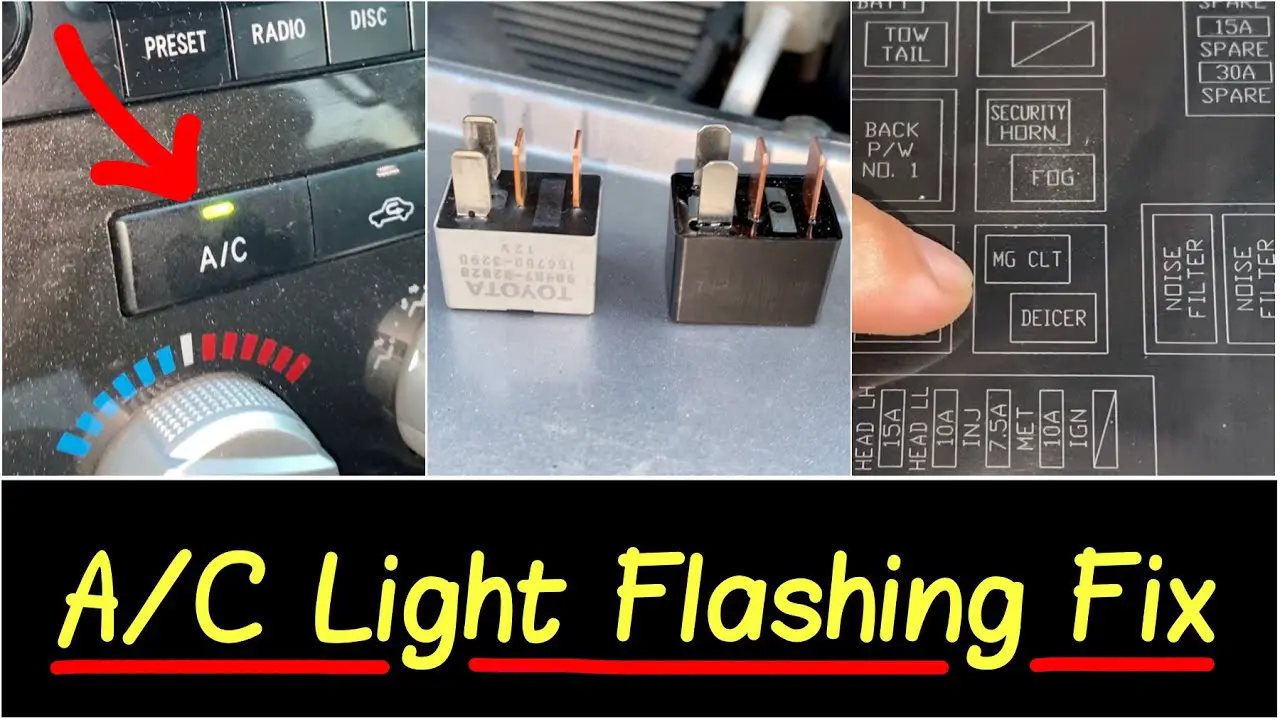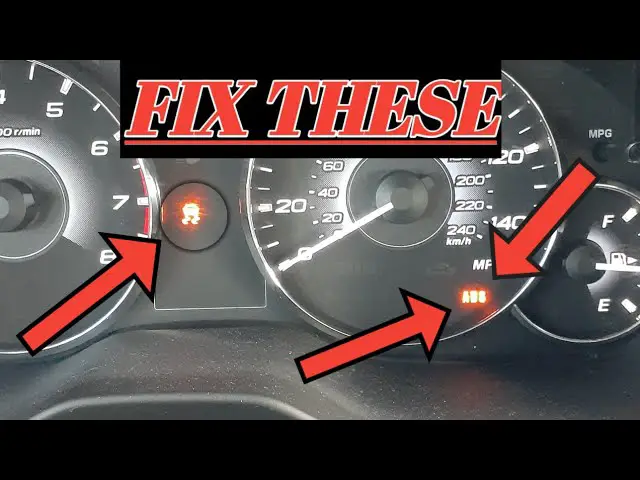If you own a BMW, you may have encountered the code P0420 on your dashboard.
This code indicates a problem with the catalytic converter, which is a vital component of the emission system.
The catalytic converter is responsible for reducing the harmful gases that come out of the engine.
However, if it is not working properly, it can affect the performance and fuel efficiency of your vehicle, as well as cause environmental damage.
In this article, we will explain what the BMW code P0420 means, what causes it, what symptoms it produces, and how to fix it.
By the end of this article, you will have a better understanding of this common error code and how to prevent it from happening again.
What Does BMW Code P0420 Mean?
The BMW code P0420 is a diagnostic trouble code that indicates a problem with the catalytic converter’s efficiency. The catalytic converter is a part of the exhaust system that reduces the harmful emissions from the engine.
It does this by using a catalyst, which is a substance that speeds up a chemical reaction without being consumed. The catalyst converts the carbon monoxide, hydrocarbons, and nitrogen oxides in the exhaust gas into carbon dioxide, water, and nitrogen, which are less harmful to the environment.
The engine control module (ECM) monitors the performance of the catalytic converter by using two oxygen sensors: one before the catalytic converter (front O2 sensor) and one after the catalytic converter (rear O2 sensor).
The front O2 sensor measures the amount of oxygen in the exhaust gas before it enters the catalytic converter, while the rear O2 sensor measures the amount of oxygen in the exhaust gas after it leaves the catalytic converter. The ECM compares the readings from both sensors to determine how well the catalytic converter is working.
A properly functioning catalytic converter should reduce the amount of oxygen in the exhaust gas, which means that the rear O2 sensor should have a lower reading than the front O2 sensor. The ECM expects the rear O2 sensor to have a steady and low voltage signal, indicating that the catalytic converter is doing its job.
However, if the catalytic converter is not working properly, it will not reduce the amount of oxygen in the exhaust gas, which means that the rear O2 sensor will have a similar or higher reading than the front O2 sensor.
The ECM will detect that the rear O2 sensor has a high and fluctuating voltage signal, indicating that the catalytic converter is not efficient enough. This will trigger the BMW code P0420, which means that the catalytic converter’s efficiency is below the threshold value set by the manufacturer.
The BMW code P0420 is a serious problem that can affect the performance, fuel economy, and emissions of your vehicle. It can also cause your vehicle to fail an emissions test, which can result in fines or penalties in some states.
What is the Function of the Catalytic Converter in Your BMW?
The function of the catalytic converter in your BMW is to reduce the harmful emissions from your engine. The catalytic converter is a part of the exhaust system that is located between the engine and the muffler. It contains a catalyst, which is a substance that speeds up a chemical reaction without being consumed.
The catalyst is usually made of rare metals such as platinum, rhodium, and palladium, and it coats a ceramic honeycomb or bead structure inside the converter.
The catalytic converter works by converting the toxic gasses in the exhaust gas into less toxic gasses before they are released into the atmosphere.
The exhaust gas from your engine contains three main pollutants: carbon monoxide (CO), hydrocarbons (HC), and nitrogen oxides (NOx). Carbon monoxide is a poisonous gas that can cause headaches, dizziness, and even death if inhaled.
Hydrocarbons are unburned fuel molecules that can cause smog, ozone depletion, and respiratory problems. Nitrogen oxides are formed when nitrogen and oxygen in the air react at high temperatures, and they can cause acid rain, smog, and respiratory problems.
The catalytic converter uses two types of reactions to reduce these pollutants: oxidation and reduction. Oxidation is a reaction that involves adding oxygen to a molecule, while reduction is a reaction that involves removing oxygen from a molecule. The catalytic converter has two chambers: one for oxidation and one for reduction.
In the oxidation chamber, the catalyst adds oxygen to carbon monoxide and hydrocarbons, converting them into carbon dioxide (CO2) and water (H2O), which are less harmful to the environment. In the reduction chamber, the catalyst removes oxygen from nitrogen oxides, converting them into nitrogen (N2) and oxygen (O2), which are harmless gases.
The catalytic converter can perform these reactions efficiently because it operates at high temperatures, around 400-800°C. The converter also needs a balanced amount of oxygen in the exhaust gas to work properly. If the exhaust gas is too rich (has too much fuel and not enough oxygen), the converter will not be able to oxidize carbon monoxide and hydrocarbons.
If the exhaust gas is too lean (has too much oxygen and not enough fuel), the converter will not be able to reduce nitrogen oxides. Therefore, the engine control module (ECM) monitors the oxygen level in the exhaust gas by using oxygen sensors and adjusts the fuel injection accordingly to maintain the optimal air-fuel ratio for the catalytic converter.
The catalytic converter is an important component of your BMW’s emission control system, as it helps to protect the environment and your health from the harmful effects of engine exhaust. By using a catalyst to convert the toxic gasses in the exhaust gas into less toxic gasses, the catalytic converter reduces the amount of pollution that your BMW produces.
How Does the Engine Control Module Detect the BMW Code P0420?

The engine control module (ECM) is the computer that controls and monitors the engine and emission system of your BMW. The ECM uses various sensors and actuators to optimize the engine performance, fuel efficiency, and emission levels. One of the sensors that the ECM uses is the oxygen sensor, which measures the amount of oxygen in the exhaust gas.
The ECM uses two oxygen sensors, one before the catalytic converter (front O2 sensor) and one after the catalytic converter (rear O2 sensor). The catalytic converter is a part of the exhaust system that reduces the harmful emissions from the engine by using a catalyst to convert them into less harmful gases.
The front O2 sensor measures the amount of oxygen in the exhaust gas before it enters the catalytic converter, while the rear O2 sensor measures the amount of oxygen in the exhaust gas after it leaves the catalytic converter.
The ECM compares the readings from both sensors to determine how well the catalytic converter is working. A properly functioning catalytic converter should reduce the amount of oxygen in the exhaust gas, which means that the rear O2 sensor should have a lower reading than the front O2 sensor. The ECM expects the rear O2 sensor to have a steady and low voltage signal, indicating that the catalytic converter is doing its job.
However, if the catalytic converter is not working properly, it will not reduce the amount of oxygen in the exhaust gas, which means that the rear O2 sensor will have a similar or higher reading than the front O2 sensor.
The ECM will detect that the rear O2 sensor has a high and fluctuating voltage signal, indicating that the catalytic converter is not efficient enough. This will trigger the BMW code P0420, which means that the catalytic converter’s efficiency is below the threshold value set by the manufacturer.
What are the Common Causes and Symptoms of the BMW Code P0420?
The BMW code P0420 indicates a problem with the catalyst system efficiency in Bank 1, which often means the catalytic converter isn’t performing as intended. Here’s a breakdown of the common causes and symptoms:
Causes
- Faulty catalytic converter: This is the most common culprit. Over time, the converter can become clogged with debris or degraded due to heat, reducing its ability to convert harmful emissions.
- Exhaust leaks: Leaks before the catalytic converter can allow excess oxygen into the exhaust stream, confusing the sensors and leading to a P0420 code.
- Sensor issues: A faulty oxygen sensor, either upstream or downstream of the converter, can send inaccurate signals to the engine computer, triggering the code.
- Rich or lean running condition: If the engine runs too rich (excess fuel) or lean (not enough fuel), it can affect the efficiency of the converter and trigger the code.
- Misfires: Engine misfires can also cause incomplete combustion, leading to unburned fuel reaching the converter and overloading it, potentially causing damage and triggering the code.
Symptoms
- Illuminated check engine light: This is the most common symptom and will alert you to a potential problem with the emissions system.
- Reduced engine performance: You might experience decreased power, hesitation, or rough idling.
- Rotten egg smell: This strong, sulfurous odor is a classic sign of a failing catalytic converter, as it’s unable to convert hydrogen sulfide emissions effectively.
- Increased fuel consumption: The engine might need to work harder to compensate for the reduced efficiency of the emissions system, leading to higher fuel usage.
Important: Can BMW run-flat tires be patched? Everything You Need To Know!
How to Diagnose and Fix the BMW Code P0420?
The BMW code P0420 means that the catalytic converter’s efficiency is below the threshold value set by the manufacturer. The catalytic converter is a part of the exhaust system that reduces the harmful emissions from the engine by using a catalyst to convert them into less harmful gasses. The code is triggered when the engine control module (ECM) detects that the catalytic converter is not converting the exhaust gasses as efficiently as it should be.
To diagnose and fix the BMW code P0420, you need to follow these steps:
- Use a scan tool to read the code and the freeze frame data. This will help you identify the conditions under which the code was set and the possible causes of the problem.
- Inspect the exhaust system for any leaks, damages, or corrosion. Check the exhaust manifold, the exhaust pipe, the gasket, the muffler, and the catalytic converter. Repair or replace any faulty parts as needed.
- Test the oxygen sensors (upstream and downstream) using a multimeter. Check the voltage and resistance of the sensors and compare them to the specifications. Replace any faulty sensors as needed.
- Test the catalytic converter using a temperature gun. Measure the temperature of the inlet and outlet of the converter and compare them to the specifications. A properly functioning catalytic converter should have a higher temperature at the outlet than at the inlet. If the temperature difference is too low or too high, the converter may be faulty and need to be replaced.
- Clear the code and test drive the vehicle. If the code does not reappear, the problem is fixed. If the code reappears, you may need to check the fuel system, the ignition system, or the engine for any problems that may affect the catalytic converter’s efficiency.
How Much Does It Cost to Replace the Catalytic Converter in Your BMW?
The cost of replacing the catalytic converter in your BMW can vary depending on the type, model, and year of your vehicle, as well as the quality and availability of the replacement part.
The average cost of replacing a catalytic converter is between $200 and $2,500, including parts and labor. However, this is just an estimate and the actual cost may be higher or lower depending on your location, the mechanic’s rate, and other factors.
For example, you can visit CarParts.com, which offers BMW catalytic converter replacement for $210. You can also use ClickMechanic or WhoCanFixMyCar to compare prices from different mechanics in your area and book a catalytic converter replacement online.
Replacing a catalytic converter is not a simple DIY job, as it requires special tools and skills to remove and install the part correctly. It is also important to follow the emission regulations and standards in your state or country, as some catalytic converters may not be compatible or legal for your vehicle.
How to Prevent the BMW Code P0420 from Happening Again?
Preventing the BMW code P0420 from happening again is essential to avoid costly repairs and ensure your vehicle’s optimal performance. Here are some preventive measures you can take:
-
Regular Maintenance
Regular maintenance of your BMW vehicle is crucial to prevent the P0420 code from appearing. Ensure that you follow the manufacturer’s recommendations for oil changes, tune-ups, fuel trim monitoring, and emission system checks. This will help you keep your engine and exhaust system in good condition and avoid any problems that may affect the catalytic converter’s efficiency.
-
Good Quality Fuel and Oil
Using good quality fuel and oil for your BMW vehicle is also important to prevent the P0420 code from appearing. Avoid using low-octane fuel or contaminated oil, as they can cause deposits and clogs in the fuel system and the catalytic converter. Also, avoid driving with a low fuel level or a misfiring engine, as they can cause unburned fuel to enter the catalytic converter and damage it.
-
Periodic Inspection
Periodically inspecting the condition of the catalytic converter and the oxygen sensors is also advisable to prevent the P0420 code from appearing. You can use a scan tool to read the code and the freeze frame data, and a multimeter to test the voltage and resistance of the sensors and the converter. You can also use a temperature gun to measure the temperature difference between the inlet and outlet of the converter. If you notice any signs of damage, wear, or inefficiency, you should replace the catalytic converter or the oxygen sensor as soon as possible.
-
Avoid Aftermarket Parts or Modifications
Avoid installing any aftermarket parts or modifications that can affect the emission system or the engine performance of your BMW vehicle. Some of these parts or modifications may not be compatible or legal for your vehicle, and they can cause the P0420 code to appear. For example, some performance chips, exhaust systems, or air intake systems may alter the air-fuel ratio or the oxygen sensor readings, and cause the ECM to detect a problem with the catalytic converter’s efficiency.
Can I still drive with a P0420 code?
You may be able to drive your car with this code, but it is not advisable. This code indicates that there is a problem with your emission system, which can cause further damage to your engine and exhaust system if left untreated. It can also result in your car failing an emissions test, which can have legal consequences in some areas.
What is the most common cause for a P0420 code?
The most common cause for a P0420 code is a faulty catalytic converter. This is the part of the exhaust system that reduces the harmful emissions from the engine by using a catalyst to convert them into less harmful gasses.
If the catalytic converter is not working efficiently, it can trigger the P0420 code, which means that the catalyst system efficiency is below the threshold value set by the manufacturer.
A faulty catalytic converter can be caused by normal wear and tear, oil contamination, incorrect placement, or damage from other engine problems. To fix the P0420 code, you may need to replace the catalytic converter or repair the underlying cause of the problem.
Can a dirty air filter cause a P0420 code?
A dirty air filter can indirectly cause a P0420 code, but it is not a direct cause. A dirty air filter can reduce the amount of air that enters the engine, resulting in a rich air-fuel mixture.
A rich mixture means that there is more fuel than oxygen in the combustion chamber, which can cause incomplete combustion and excess fuel to enter the exhaust system.
This can damage the catalytic converter, which is the part of the exhaust system that reduces the harmful emissions from the engine by using a catalyst to convert them into less harmful gases.
If the catalytic converter is damaged, it will not be able to convert the exhaust gases efficiently, and the engine control module (ECM) will detect this and trigger the P0420 code.
What are the effects of the P0420 code?
Some of the effects of the P0420 code are:
-
Increased emissions
The catalytic converter is responsible for reducing the harmful gases that come out of the engine, such as carbon monoxide, hydrocarbons, and nitrogen oxides. If the catalytic converter is not efficient enough, these gases will be released into the atmosphere, contributing to air pollution and global warming.
-
Reduced fuel efficiency
The catalytic converter also helps to optimize the fuel consumption of your vehicle by maintaining a balanced air-fuel ratio. If the catalytic converter is not efficient enough, the engine control module (ECM) may adjust the fuel injection to compensate, resulting in more fuel being used and less mileage being achieved.
-
Reduced performance
The catalytic converter also affects the engine performance and power of your vehicle by creating a back pressure in the exhaust system. If the catalytic converter is not efficient enough, the back pressure may be too high or too low, causing the engine to lose power or stall.
-
Failed emission test
The catalytic converter is one of the components that is checked during an emission test, which is required in some states or countries to ensure that your vehicle meets the emission standards. If the catalytic converter is not efficient enough, your vehicle may fail the emission test, which can result in fines or penalties.
Can spark plugs cause the P0420 code?
Spark plugs are the components that ignite the air-fuel mixture in the combustion chamber of the engine. They create a spark that jumps from the center electrode to the ground electrode, causing the mixture to burn and produce power.
Spark plugs can wear out over time or become damaged by various factors, such as oil contamination, carbon deposits, or overheating. When this happens, they may not be able to produce a strong and consistent spark, resulting in incomplete combustion and misfires.
Spark plugs can indirectly cause P0420 code, but they are not a direct cause. When one or more spark plugs are faulty, they are not able to ignite the air-fuel mixture properly, so some of the mixture remains unburned and enters the exhaust system.
This unburned mixture, along with the nitrogen oxides and carbon monoxide from the combustion chamber, will go into the catalytic converter. This puts extra load on the catalytic converter, which is designed to convert these gasses into less harmful ones, such as carbon dioxide, water, and nitrogen.
However, if the catalytic converter is overloaded with an unburned mixture, it may not be able to perform its function efficiently, and the ECM will detect this and trigger the P0420 code.
Is P0420 an exhaust leak?
No, P0420 is not an exhaust leak code.
P0420 means that the catalytic converter’s efficiency is below the threshold value set by the manufacturer.
The catalytic converter is a part of the exhaust system that reduces the harmful emissions from the engine by using a catalyst to convert them into less harmful gasses.
The code is triggered when the engine control module (ECM) detects that the catalytic converter is not converting the exhaust gasses as efficiently as it should be.
However, an exhaust leak can indirectly cause a P0420 code, if the leak is before or near the oxygen sensor that monitors the catalytic converter’s performance.
An exhaust leak can introduce extra oxygen into the exhaust system, which can affect the oxygen sensor’s readings and make the ECM think that the catalytic converter is not working properly.
Conclusion
The BMW Code P0420 means that your catalytic converter is not working efficiently.
This can affect your vehicle’s performance, fuel economy, and emissions.
The code can be caused by various problems, such as a faulty oxygen sensor, an exhaust leak, a fuel system problem, an ignition system problem, an engine problem, or a damaged catalytic converter.
To fix the code, you need to diagnose the problem and replace or repair the faulty component.
You should also prevent the code from happening again by maintaining your vehicle regularly and using good-quality fuel and oil.




